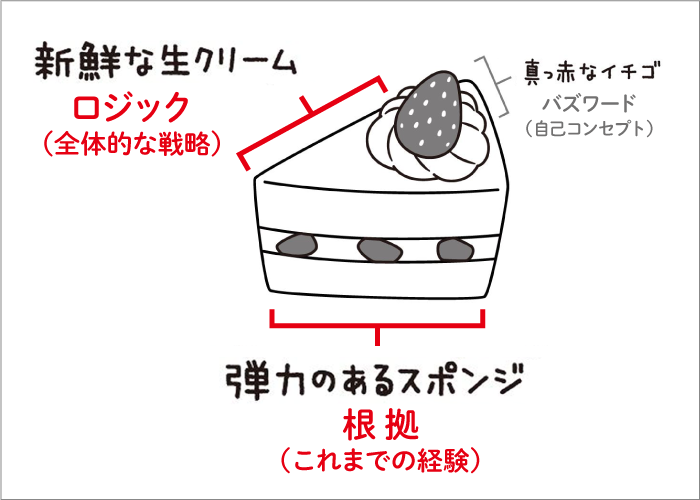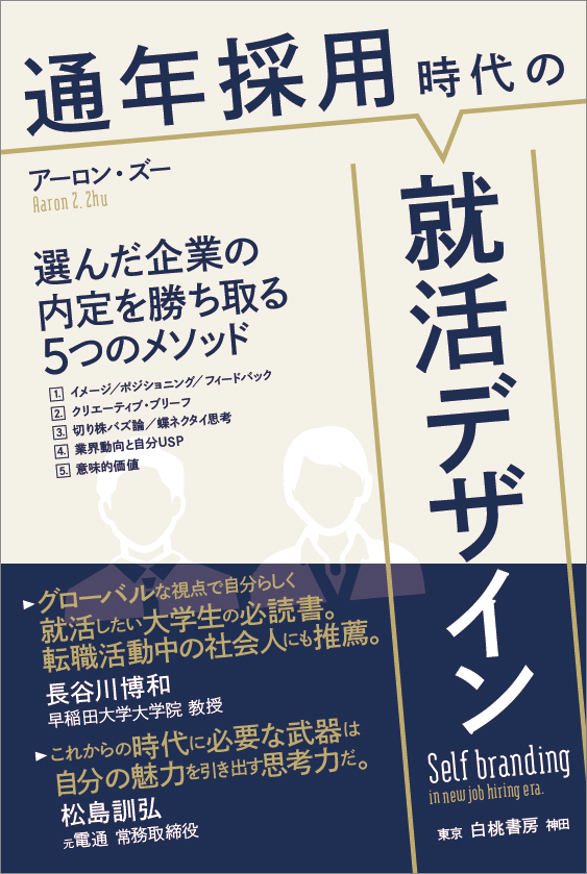新著『通年採用時代の就活デザイン』(白桃書房)と連動した連載コラム。前回 は、個の活動が今まで以上に重視され、時期に関係なく企業から内定をもらう学生が増える「通年採用時代」がやってくることと、そのような時代に自分の魅力をうまくアピールするためには、「自分をショートケーキ化する」ことが大事なことを述べました。今回は、その中身を簡単に紹介します。
ロジックは、クリエーティブ・ブリーフを活用して組み立てる
就活の軸を決めて、ES(エントリーシート)を作成することは、就活において根幹の部分です。「ショートケーキ思考」では、まず「生クリーム」に当たる「ロジック」から設計していき、「弾力のあるスポンジ」に例えられる「根拠」(自身の経験)をつくっていく必要があります。

では、「生クリーム」から説明しましょう。ショートケーキの中でも外部の空気と触れる面積が最も多い生クリームは、就活に例えると全体的な「ロジック」です。「なぜこの業界を志望しているのか」「なぜ御社に入りたいのか」といった志望理由を論理的に組み立てることは、軸やESを作成する上で欠かせない重要なステップになります。
しかし、この「ロジック」の構築は簡単に見えてかなり難易度が高い。ちゃんと考えないと面接官に不意を突かれ、面接のペースが狂ってしまいます。特に面接慣れしていない学生は、ここでシドロモドロになり、落胆してしまうことも多いようです。
この主な原因は、全体的なロジックの設計ミスにあります。ネット検索やOB・OG訪問でさまざまな情報を引っ張ってきただけでは、志望理由をロジカルに組み立てられていないので、どの情報をどの質問に当てはめて答えればよいのか整理ができていません。
このロジックの骨組みの構築に活用できるのが、広告プランニングで使われている「クリエーティブ・ブリーフ」というフォーマットです。これは広告の設計図のようなもので、全体のロジックをまとめる上で非常に役立ちます。
このようにクリエーティブ・ブリーフを用いると、志望理由や将来の方向性、誰にどうやって自分をアピールしていくべきかが明確になります。
グラつかない自身の経験が、就活の土台となる
ロジックがしっかりしているだけでは、企業の面接官を説得する十分な材料にはなりません。学生の皆さんが卒論を書く時に新しい仮説を提唱する場合、参考文献やいろいろなデータを使って立証するでしょう。では就活での立証材料は何か?それは学生自身の経験です。クリエーティブ・ブリーフの中にも「信じられる根拠」という項目がありますが、これはあくまでも根拠の概要であって、もっと深掘りしていく必要があります。
学生時代に力を入れたこと(自身の経験)こそ、なぜその業界や企業を志望するのかの根拠になるもの。ショートケーキでいえば、ケーキの土台となる「弾力のあるスポンジ」です。
学生の就活相談を受ける中で、私が感じる大きな違和感は、根拠が不十分であることです。どんなにクリエーティブ・ブリーフをうまく描いても、本当にそれを実行し「根拠として立証」できなければ、面接官を説得できません。
この根拠は学生時代の挑戦や経験が大きく影響するので、同じインターンやアルバイトの経験をどの企業の就活にも使い回していては、まったく意味をなしません。「志望業界や企業にどれだけ近い経験をしたのか」「その経験でどれだけ努力し、社会人として期待できるか」を面接官はしっかりチェックしています。
就活ルールの廃止で優秀な人材はいつでも企業からオファーをもらう可能性がある通年採用の時代に、根拠のスポンジ部分がグラグラでは商品(ケーキ)として店舗にさえ並べられません。根拠(これまでの勉強や経験)を、クリエーティブ・ブリーフという「ロジック」に連結させることを意識しながら、就活の対策を練ることが大事です。
次回は、真っ赤なイチゴ(自分を象徴するバズワード)について説明します。

四六版、148ページ、定価:1400円+税、ISBN978-4-561-51107-6 C0034






